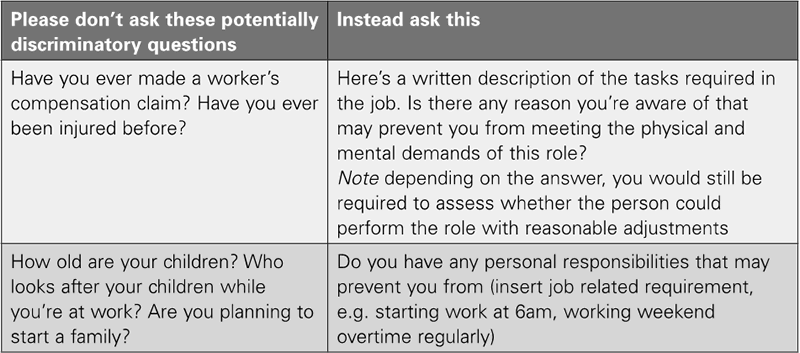Managing the risk of a new employee starts with an effective recruitment process.
It’s worth starting off a new employment relationship with all your i’s dotted and t’s crossed. That way, if things start to go awry, you’ve done the groundwork to protect the business from the consequences of various claims. Thinking through the process and documenting your decision making is a good basis for considered action.
What type of work really needs to be done?
The best time to consider whether a restructure of the work is warranted is prior to recruiting another employee. You may wish to consider alternatives to appointing another employee, for example:
Transferring or promoting another staff member;
Changing the other employees’ jobs to incorporate the tasks from this position; or
Offering overtime to existing employees.
You’ll also need to decide whether the job is to be full time, part time, or casual. Please bear in mind recent case law regarding casuals who work regular and systematic hours on a prolonged basis – failing to review these arrangements could result in a court order to pay the employee entitlements under the National Employment Standards. It’s also worth revisiting the May 2020 changes to the Timber Industry Award 2010 allowing casuals to request conversion after 12 months.
If you decide to go ahead with hiring, then attention to detail in the following will help:
Advertise the position
When you are writing the advertisement, you will need to be specific about the key selection criteria, the key skills and attributes. For example, if you need a Leading Hand who is capable of supervising a team of assemblers, specify this in the job advertisement.
Interview suitable applicants
Decide how much time you will need for each interview and schedule interviews when you know you will have enough time to interview each candidate properly.
In order to ensure a fair process, ask each employee the same, or similar, questions. All questions should relate to job requirements. Check the table below to avoid phrasing that may be discriminatory.

Conduct selection tests if appropriate
You may wish to test a candidate’s written or computer skills, or you may wish to see the candidate perform a relevant task, such as driving a forklift. The task needs to be directly relevant to the work the candidate may be asked to perform, to avoid any possibility that selection tests could discriminate unlawfully. If you require someone to work for longer than it would reasonably take to demonstrate some simple tasks, you will need to pay them for their time.
Pre-employment medicals
Pre-employment medical assessments can be a useful recruitment tool and can provide you with baseline information about employees. However, refusing to employ someone on the basis of a medical review can be tricky, and potential options need to be carefully assessed. Pre-employment drug and alcohol screening can also be a useful tool provided it is conducted in accordance with your clearly documented policy.
Some jurisdictions specify that if an employee is required to use hearing protection as part of their job, their hearing should be tested on recruitment, and then periodically thereafter.
Conduct reference and background checks
These are important and should not be overlooked. Speaking to a former employer can tell you a lot about a candidate, particularly if you read between the lines.
Ask the candidate to give you the names and contact details of referees, ideally two or three. Bear in mind that some people have a policy of not giving references, and the candidate should only have given you the names of people willing to speak to you.
Contact the referees and ask them about aspects of the candidate’s likely performance in the role you want to fill, based on the previous employer’s experience with the employee. For example, if you are trying to fill a customer service role, you might ask a referee how well the candidate got on with customers. You can also ask if the candidate was punctual, well groomed and courteous.
You can check with previous employers (even those that are not offered as referees) that the candidate actually worked for the employer for the stated time. It is advisable to check any claimed qualifications with the issuing authority. You would be asking whether the certificate is genuine – a scanner and a colour printer can produce a remarkably convincing qualification.
You should also check that the candidate has the right to work in Australia – to this end you are entitled to request a copy of the candidate’s Australian birth certificate or certificate of naturalisation, or evidence of the candidate’s authority to work in Australia. You can check an employee’s right to work at www.immi.gov.au. Failure to undertake these checks could expose you to prosecution.
Offer the position to the preferred candidate
The initial offer of employment can be verbal, but definitely follow it up with a written offer, including an explanation of terms and conditions of employment. If the position is covered by an award or enterprise agreement, then the offer of employment must be consistent with the terms of that document. Be aware that if you operate in the federal industrial relations system, you cannot make the offer of employment subject to the candidate making an Individual Flexibility Arrangement under an award or agreement.
Additional note on the 2020 minimum wage increases
On 19 June 2020, the Fair Work Commission decided to increase minimum wages in modern awards by 1.75%. While usually increases in minimum rates are operative from 1 July each year, many of these increases have been delayed because of the economic impact of Covid-19.
Minimum rates for employees engaged to perform work covered by the following awards will increase from the first pay period commencing on or after 1 November 2020:
- Timber Industry Award 2010
- Clerks Private Sector Award 2010
- Road Transport and Distribution Award 2010
Minimum rates for employees engaged to perform work covered by the General Retail Industry Award 2010 will not increase until the first pay period commencing on or after 1 February 2021.
This information is relevant for all national system employers in Australia. Sole traders and partnerships in Western Australia remain covered by the State industrial relations system. Wage rates in the WA state system will increase by 1.75% on 1 January 2021. Visit www.wairc.gov.au for more information.











